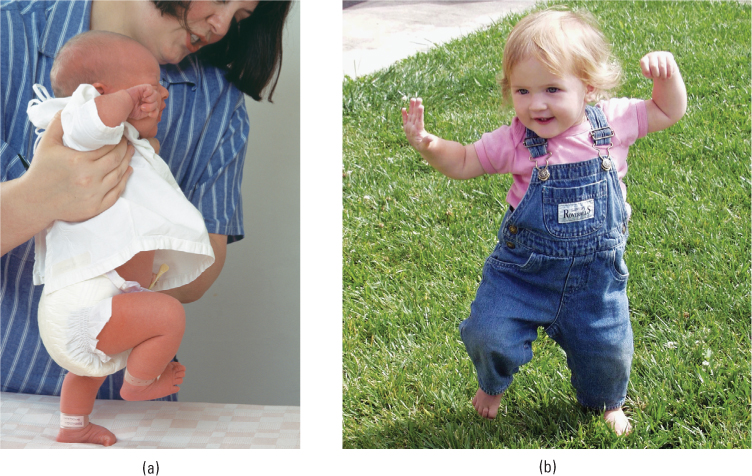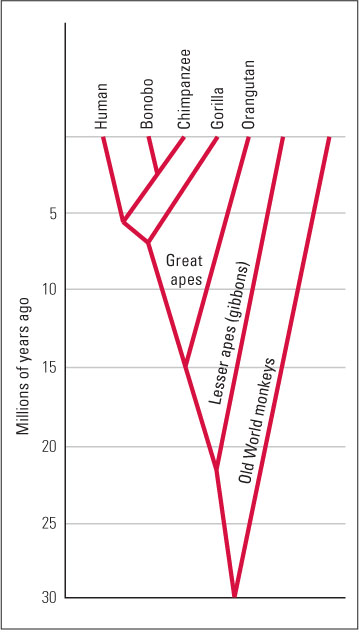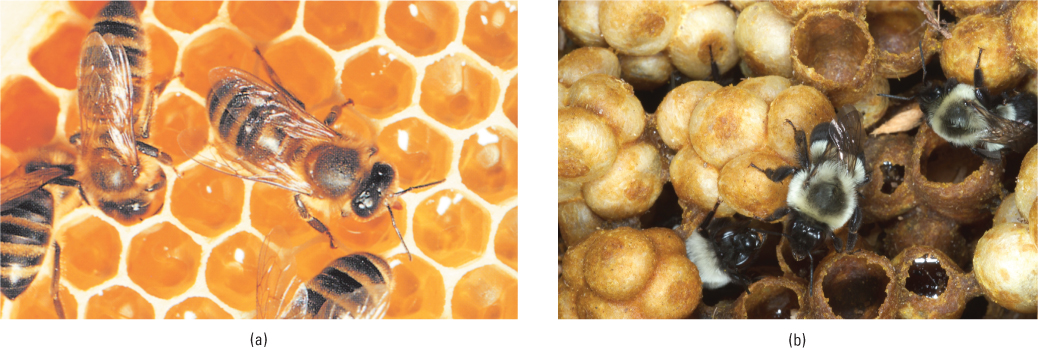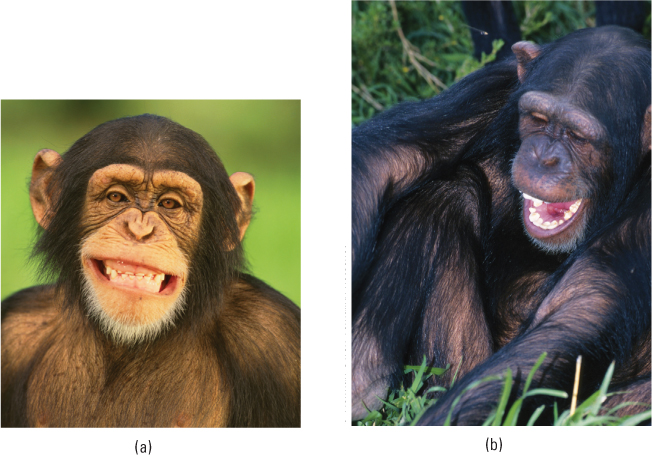3.5 Natural Selection as a Foundation for Understanding Species-Typical Behaviors
Suppose you saw an animal that looked exactly like a dog, but it meowed, climbed trees, and ignored the mail carrier. Would you call it a dog or a cat? Clearly, we identify animals as much by their behavior as by their anatomy. Every species of animal has certain characteristic ways of behaving. These are commonly called instincts, but a more technical term for them is species-typical behaviors. Meowing, tree climbing, and acting aloof are species-typical behaviors of cats. Dam building is species-typical of beavers. Smiling, talking, and two-legged walking are species-typical of humans.
Many psychologists (particularly developmental psychologists) avoid using the word “instinct” and the related term “innate” for two reasons. First, they imply “no experience necessary” and this is associated with genetic determinism, the belief that genes “determine” behavior independent of experience; and second, because “instinct” is not easily defined. And, as Patrick Bateson wrote (2002, p. 2212):
Apart from its colloquial uses, the term instinct has at least nine scientific meanings: present at birth (or at a particular stage of development), not learned, developed before it can be used, unchanged once developed, shared by all members of the species (or at least of the same sex and age), organized into a distinct behavioral systems (such as foraging), served by a distinct neural module, adapted during evolution, and differences among individuals that are due to their possession of different genes. One does not necessarily imply another even though people often assume, without evidence, that it does.
For these reasons, we will use the term ‘instinct’ sparingly in this book, using the more descriptive term “species-typical behaviors.”
Species-Typical Behaviors in Humans
Species-typical behaviors are products of evolution, but that does not mean that they are necessarily rigid in form or uninfluenced by learning. To understand more fully the concept of species-typical behaviors, let us examine some examples in human beings.
Human Emotional Expressions as Examples of Species-Typical Behaviors
24
What evidence supports the idea that many human emotional expressions are examples of species-typical behaviors?
Darwin noted that humans, like other animals, automatically communicate moods and behavioral intentions to one another through body postures, movements, and facial expressions. In his book The Expression of the Emotions in Man and Animals, Darwin (1872/1965) argued that specific facial expressions accompany specific emotional states in humans and that these expressions are universal, occurring in people throughout the world and even in people who were born blind and thus could not have learned them through observation.
79
In an extension of Darwin’s pioneering work, Paul Ekman and Wallace Friesen (1975, 1982) developed an atlas that describes and depicts the exact facial-muscle movements that make up each of six basic emotional expressions in people: surprise, fear, disgust, anger, happiness, and sadness (see Figure 3.12). They then showed photographs of each expression to individuals in many different cultures, including members of a preliterate tribe in the highlands of New Guinea who had little previous contact with other cultures. They found that people in every culture described each depicted emotion in a way that was consistent with descriptions in the United States (Ekman, 1973; Ekman et al., 1987). In a reversal of this procedure, they also photographed members of the New Guinea tribe who had been asked to act out various emotions and showed the photographs to college students in the United States. The college students were quite accurate in labeling the emotions portrayed by the New Guineans.

In a further extension of Darwin’s work, Irenaus Eibl-Eibesfeldt (1989) documented the cross-cultural universality of many nonverbal signals, including one that he labeled the eyebrow flash, a momentary raising of the eyebrows lasting about one-sixth of a second, usually accompanied by a smile and an upward nod of the head (see Figure 3.13). He observed this expression in every culture he studied—including those in New Guinea, Samoa, and various parts of Africa, Asia, South America, and Europe—and concluded that it is a universal sign of greeting among friends. Raised eyebrows are also a component of the emotional expression of surprise (look at Figure 3.12 again), so the eyebrow flash with its accompanying smile might be interpreted as a nonverbal way of saying, “What a happy surprise to see you!”

25
How do human emotional expressions illustrate the point that species-typical behaviors can be modified by learning?
Eibl-Eibesfeldt (1975) also filmed children who were born blind, or both blind and deaf, and found that they manifest emotions in the same basic ways as sighted children do (see Figure 3.14). Such observations provide the most direct evidence that at least some human expressions do not have to be learned through observing them in others or hearing descriptions of them.

Taking all the evidence together, there can be little doubt that we are biologically predisposed to express certain emotions in certain species-typical ways. It is also clear, however, that we can control and modify our emotional expressions and learn new ones. Even researchers who focus on universal expressions are quick to point out cross-cultural differences. For example, Eibl-Eibesfeldt (1975) found that despite its cross-cultural similarity in form and general meaning, large cultural differences exist in the use of the eyebrow flash. The Japanese, who are reserved in social expressions among adults, use it mainly when greeting young children, whereas Samoans, at the other extreme, greet nearly everyone in this way. More recently, researchers have shown that cultural dialects occur in the emotional expressions that Ekman and Friesen included in their atlas. In general, people can identify each emotion more easily and accurately when it is expressed by other members of their own culture than when it is expressed by members of a very different culture (Elfenbein & Amady, 2003; Elfenbein et al., 2007).
80
The Role of Learning in the Development of Species-Typical Behaviors
26
How do the examples of two-legged walking and language in humans, and singing in white-crowned sparrows, illustrate the point that species-typical behaviors may depend on learning?
To say that a behavior is species-typical is not to say that it is unaffected by learning. As we just pointed out, our basic emotional expressions are species-typical, but cultural differences among them are learned. The role of learning is even more obvious in two of our most characteristic species-specific behaviors—our manner of walking and our use of language.
A scientist from Mars would almost certainly point to two-legged walking and use of a grammar-based language as among the defining behavioral characteristics of the human species. These characterize humans everywhere and clearly depend on inherited predispositions, yet their development also clearly depends on learning.
During the peak months of learning to walk (generally during the second year of life), infants spend an average of about 6 hours per day practicing balancing and walking and, on a typical day, take about 9,000 walking steps and travel the length of 29 football fields (Adolph et al., 2003). For the most part they are not trying to get to any particular place; they are just walking for the sake of walking. By the time they are proficient walkers, they have spent thousands of hours practicing, on their own initiative. During those same months, infants also, on their own initiative, intensely practice talking. With language, infants do not just learn the motor coordination needed to produce the sounds; they also, and more amazingly, learn the basic vocabulary and grammar of the language that they hear around them. Two-legged walking and talking are species-typical behaviors in humans, but a human raised in an environment where either of these capacities was impossible to practice would not develop that capacity. Such an inhuman environment would not produce a normal human being.
Learning plays crucial roles in the development of species-specific behaviors in other animals as well. For example, white-crowned sparrows develop the ability to sing their species-typical song only if they are permitted to hear it during the first summer after hatching (Marler, 1970). Indeed, populations of the species living in different areas have somewhat different dialects, and young birds learn to sing the dialect that they hear (Nelson et al., 2004). Yet the range of possible songs that the birds can learn is limited by their biology. No matter what its environmental experiences, a white-crowned sparrow cannot learn to sing like a canary or like any species other than a white-crowned sparrow.
Biological Preparedness as the Basis for Species-Typical Behaviors
The difference between behaviors that we call instinctive, or species-typical, and those that we do not so label has to do with their degree of biological preparedness. Natural selection has equipped each species with anatomical structures, in the brain and elsewhere, that ensure that normal individuals of the species, who grow up in a normal environment for that species, will be physically able to perform their species-typical behaviors and will be motivated to learn what they must for adequate performance.
81

© Geri Engberg/The Image Works
27
How is the concept of biological preparedness related to that of species-typical behavior? How do the examples of human walking and talking illustrate biological preparedness?
We humans come into the world biologically prepared to learn to walk on two legs. Natural selection has provided us with anatomical features—such as strong hindlimbs with feet, weaker forelimbs without feet, an upwardly tilted pelvis, and a short, stiff neck—that combine to make it more convenient for us to walk upright than on all fours. Moreover, we are born with neural systems in the brain and spinal cord that enable us to move our legs correctly for coordinated two-legged walking and with neural structures that motivate us to practice this behavior at the appropriate stage in our development. Consider the difference between two-legged walking in humans and in dogs. Dogs are capable of learning to walk on two legs, and much is made of that fact by circus trainers, but they are never very good at it. They do not have the appropriate muscular and skeletal systems to coordinate the behavior properly, and they have no natural impulse to walk in this manner. A dog, unlike a human child, will practice two-legged walking only if it receives immediate rewards, such as food, for doing so. Thus, two-legged walking is not a species-typical behavior in dogs.
The same is true for talking. Humans are born with anatomical structures, including a larynx and a flexible tongue, that can produce a wide range of sounds and with a brain that has special neural centers for understanding and producing language. Infants begin talking at a certain stage even if they receive little encouragement from those around them. Chimpanzees can be taught to simulate some aspects of human language, just as dogs can be taught to walk on their hind legs, but they require lots of encouragement and are never very good at it.
Species-Typical Behavior Is a Relative Concept
28
Why is the concept of species-typical behavior relative rather than absolute?
Having characterized the concept of species-typical behavior in terms of biological preparedness, we must now add that the concept is relative rather than absolute. No behavior stems just from biological preparedness; some sort of experience with the environment is always involved. Conversely, any behavior that an individual can produce—no matter how artificial it may seem or how much training is required—must make use of the individual’s inherited biological capacities. The concept of species-typical behavior is useful as long as we accept it as relative and do not argue about whether a given behavior really should or should not be called species-typical.
82
The question to ask when we study a particular behavior is not, Is this a species-typical behavior? Rather, the meaningful questions are these:
- What are the environmental conditions needed for the full development of this behavior?
- What internal mechanisms are involved in producing this behavior?
- What consequences does this behavior have in the individual’s daily life?
- In the course of evolution, why would the genes that make this behavior possible have been favored by natural selection?
These questions can be asked of any behavior, regardless of whether or not it is thought of as species-typical.
The Value of Cross-Species Comparisons of Species-Typical Behaviors
In psychology as well as biology, scientists have learned a lot about our species by comparing us to other animals. The basic rationales for learning about any one species by comparing it with others are found in the principle of evolution by natural selection.
Two Forms of Cross-Species Comparison: Homologies and Analogies
29
What is the difference between a homology and an analogy, and how can researchers tell whether a similarity between two species in some trait is one or the other?
An understanding of evolution makes it clear that two conceptually different classes of similarities exist across species: homologies and analogies.
A homology is any similarity that exists because of the different species’ common ancestry. All animals originated from a common ancestor, so it is not surprising that some homologies—such as those in the basic structure of DNA molecules and of certain enzymes—can be found between any two species. But the more closely related two species are, the more homologies they show.

Much research has been done contrasting humans with chimpanzees and bonobos. As we noted earlier in this chapter, humans share more than 98 percent of their DNA with each of these great apes, making them our closest genetic relatives. However, it is not the case that humans evolved from chimpanzees or bonobos. Rather, we shared a common ancestor with these animals, which lived in African between 5 and 7 million years ago. That ancestor was likely very chimp-like, but over the course of the next several million years evolved into at least three lines that eventually led to modern humans, chimpanzees, and bonobos. Figure 3.15 shows the evolutionary relationship of humans to the great apes and old world monkeys.
An analogy, in contrast, is any similarity that stems not from common ancestry but from convergent evolution. Convergent evolution occurs when different species, because of some similarity in their habitats or lifestyles, independently evolve a common characteristic.
83
As an illustration, consider some comparisons among species that can fly. Flying has arisen separately in three taxonomic groups: birds, some insects (such as butterflies), and some mammals (bats). Similarities across these three groups in their flying motions, and in the anatomical structures that permit flight, are examples of analogies because they do not result from common ancestry (see Figure 3.16). However, similarities in flight and wings among species within any of these groups, such as between crows and sparrows, are likely to be homologies. The last common ancestor between a crow and a sparrow was itself a bird with wings, but the last common ancestor between a crow and a butterfly, or between a crow and a bat, did not have wings.

Dr. Merlin D. Tuttle/Bat Cons. Int’l/Science Source
© James Carmichael Jr./NHPA/Photoshot
The Value for Psychology of Studying Homologies
30
How are homologies used for learning about (a) the physiological mechanisms and (b) the evolutionary pathways of species-typical traits?
Homologies are useful for research on the physiological mechanisms of behavior (that is, research on how the brain and other biological structures operate to produce the behavior being studied). Because convergent evolution can produce similar behaviors that operate through different mechanisms, researchers who seek to understand the physiological mechanism of some behavior in humans through experiments on other species must study species in which the relevant behavior is homologous, not analogous, to that in humans. Many basic mechanisms of learning, motivation (such as hunger), and sensation (such as vision) are homologous across all or at least most species of mammals, and we have learned much about these by studying them in mice, rats, cats, and other laboratory mammals.
Homologies are also useful for inferring the pathways along which species-typical behaviors evolved. By comparing the different forms of a particular species-typical behavior in closely related species, it is often possible to reconstruct how the more complex of these forms evolved through a series of steps from the simpler form. Darwin (1859/1963) himself used this method to figure out the evolutionary steps through which honeybees acquired their marvelous ability to construct complex hives consisting of wax combs of closely fitting hexagonal cells in which to store honey and larvae (see Figure 3.17).

© Scott Camazine/Alamy
Homologies as Clues to the Evolutionary Origins of Two Human Smiles
In research that is more directly relevant to psychology, Darwin also used homologies to understand the origins of species-typical emotional expressions in humans. He watched monkeys and apes at the London Zoo and noted that a number of their expressions seemed to be homologous to human expressions, including the smile (Darwin, 1872/1965). Research following up on Darwin’s work has suggested that people may produce two kinds of smiles, which may have separate evolutionary origins.
People smile in two quite different contexts: (1) when genuinely happy and (2) when wishing to show another person that they are favorably disposed toward that person. The latter situation need not entail happiness at all; in fact, people are especially likely to smile at others in potentially tense circumstances, apparently as a means of reducing the tension (Goldenthal et al., 1981). Darwin (1872/1965) pointed out that these two smiles are anatomically distinct. The happy smile involves not just the turning up of the corners of the lips but also the pulling in of the skin near the outside corners of the eyes. This creates the creases called crow’s feet, which radiate from the eyes and seem to make them sparkle. The other smile, in contrast, typically involves the lips alone, without the eyes. This distinction has been confirmed in many studies with both adults and young children (Ekman, 1992; Sarra & Otta, 2001). In one study, for example, 10-month-old infants smiled with eyes and mouth when approached by their mother (presumably a happy situation) but smiled with mouth alone when approached by a stranger (a possibly tense situation) (Fox & Davidson, 1988).
84
Ekman (1992) considers the mouth-alone smile to be a derivative of the happy smile. He emphasizes its use in masking one’s true feelings and calls it a “false smile.” An alternative possibility, supported by research with monkeys and apes, is that the mouth-alone smile is a unique expression—let’s call it the greeting smile—that arrived through a different evolutionary route from the happy smile (Redican, 1982).
31
How do studies of homologies between humans and other primates support the view that the human greeting smile and the human happy smile have separate evolutionary origins?
Nonhuman primates manifest two distinct smile-like displays. The one that seems most clearly to be homologous to the human greeting smile is the silent bared-teeth display (see Figure 3.18a). This facial expression involves contraction of the same facial muscles as are involved in the human greeting smile (Parr et al., 2007). In macaque monkeys this display seems to have evolved as a means for a more submissive animal to look at a more dominant one without provoking a fight. If it could be translated into words, it might be rendered as, “I’m looking at you but I’m not going to attack, so please don’t attack me.” This type of display takes on a new function in chimpanzees, something more similar to that of the human smile of greeting (van Hooff, 1972, 1976). Both the more submissive and the more dominant of two chimpanzees show the display upon meeting, and it usually precedes friendly interaction between them. As used by the more submissive individual, it may retain its original meaning, “Please don’t attack me,” but as used by the more dominant, it may mean, “Rest assured, I won’t attack,” and as used by both it may mean, “Let’s be friends.”

Norman Owen Tomalin/Photoshot
85
The other primate smile-like expression is the relaxed open-mouth display, or play face (see Figure 3.18b), which occurs mostly in young primates during playful fighting and chasing and is most clearly homologous to human laughter. It involves the same facial muscles as are involved in human laughter (Parr et al., 2007), and in chimpanzees it is often accompanied by a vocalized ahh ahh ahh, which sounds like a throaty human laugh. This display apparently originated as a means for young primates to signal to each other that their aggressive-like behavior is not to be taken seriously; nobody will really get hurt. Interestingly, in human children, laughter occurs during playful fighting and chasing more reliably than during any other form of play (Blurton-Jones, 1967). Thus, our laughter is not only similar in form to the relaxed open-mouth display of other primates but also, at least in some cases, seems to serve a similar function.
The Value for Psychology of Studying Analogies
32
How can we use analogies to make inferences about the distal functions of species-typical traits?
You have just seen examples of how homologies can be used to make inferences about the evolutionary origins of species-typical behaviors. Analogies, in contrast, are not useful for tracing evolutionary origins but are useful for making inferences about the distal functions of species-typical behaviors. If different species have independently evolved a particular behavioral trait, then comparing the species may reveal commonalities of habitat and lifestyle that are clues to the distal function of that trait. You will see examples of this use of analogies in the remaining sections of this chapter, as applied to patterns of mating, patterns of aggression, and patterns of helping.
SECTION REVIEW
Species-typical behaviors have come to exist through natural selection.
Species-Typical Behaviors
- Species-typical behaviors are ways of behaving that characterize a species—such as cats meowing and humans walking upright.
- They may be influenced by learning or even require learning, as exemplified by cultural differences in the eyebrow flash, human Language Learning, and white-crowned sparrows’ song development.
- They depend upon biological preparedness—that is, upon having anatomical structures that permit and motivate the behavior.
Homologies and Analogies
- Homologies are similarities due to common ancestry. They are useful for studying underlying mechanisms and for tracing the evolutionary course of species-typical behaviors, exemplified by research on the greeting smile and happy smile in humans.
- Analogies are similarities due to convergent evolution (independent evolution of similar traits). They are useful for inferring distal functions.